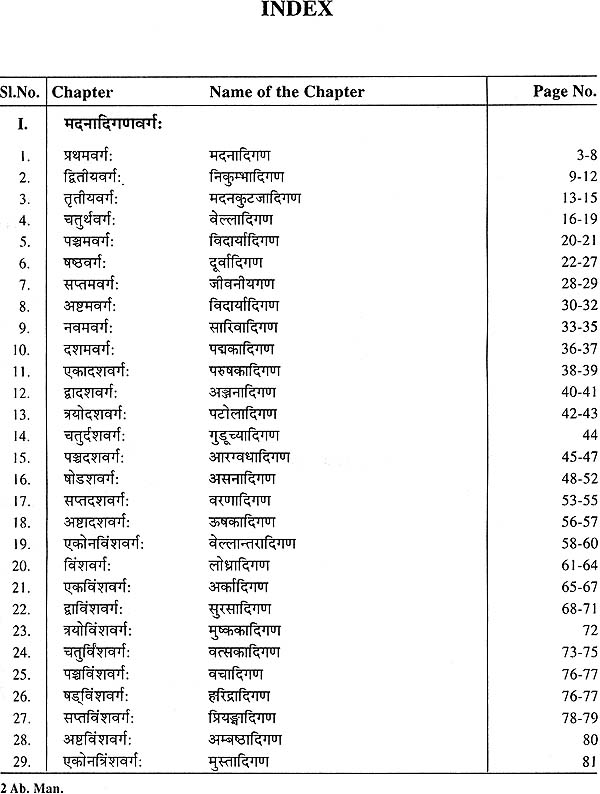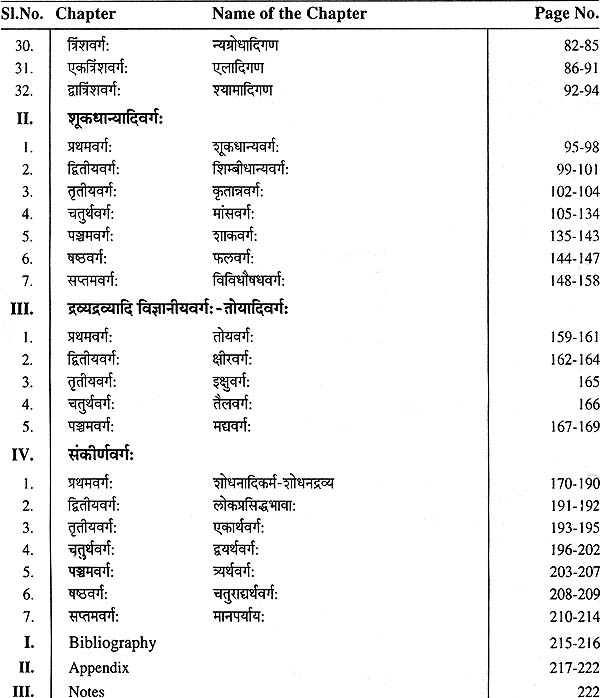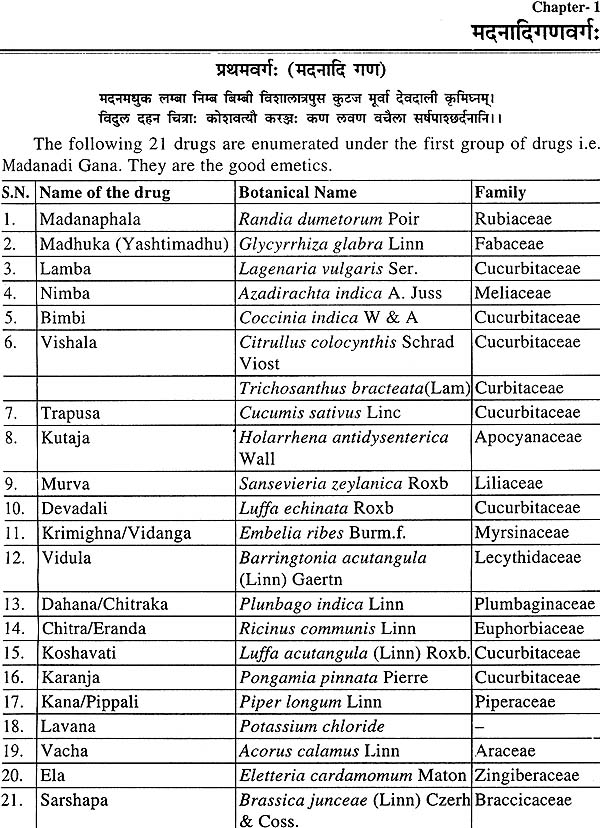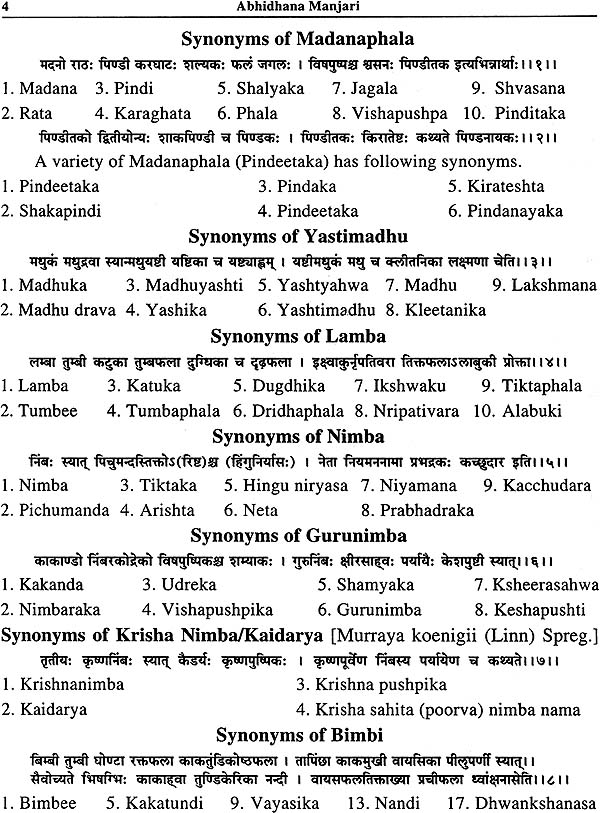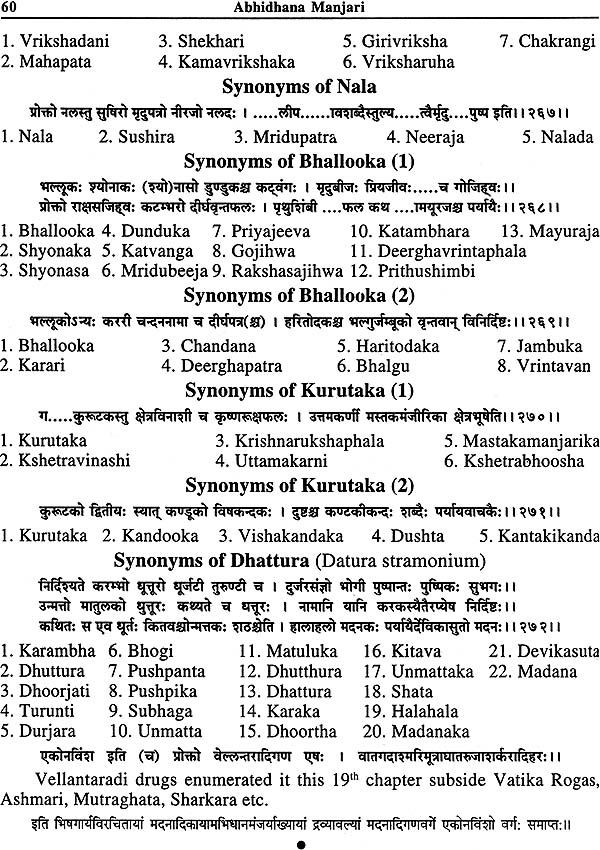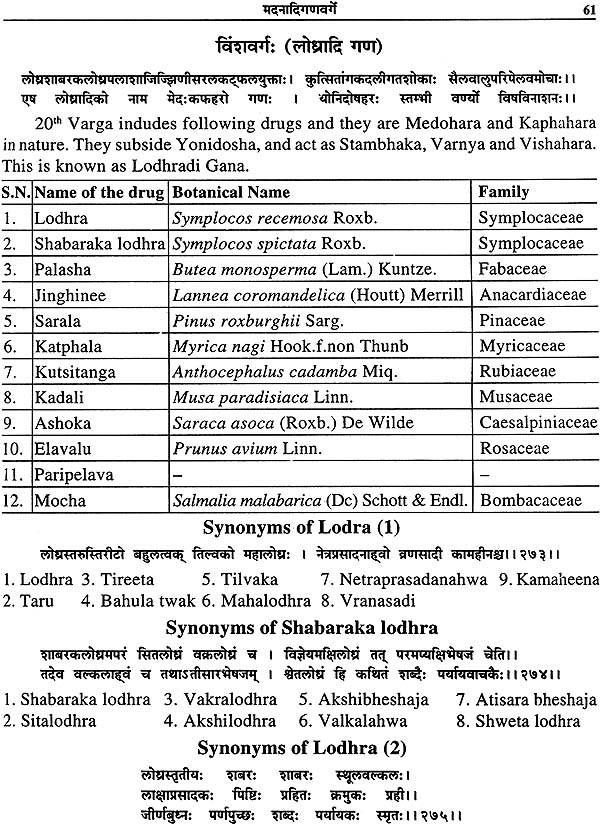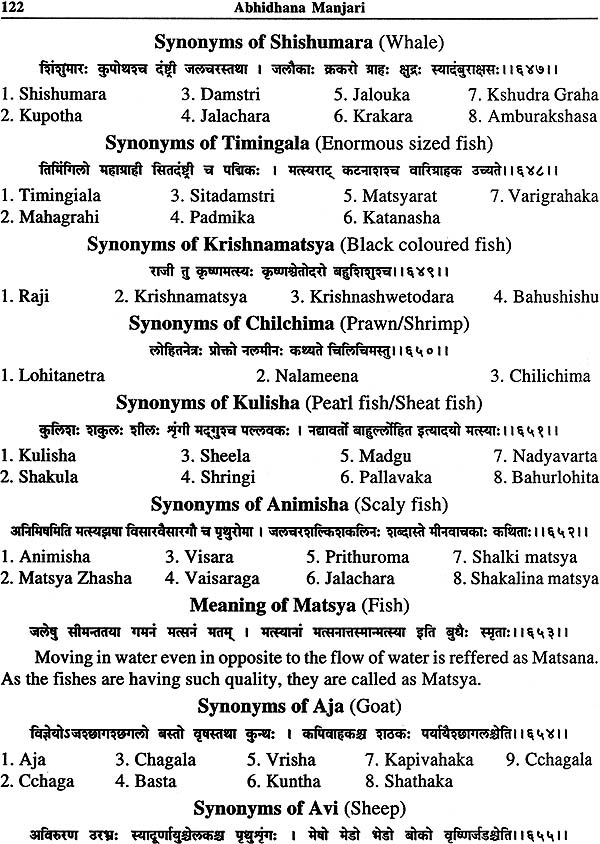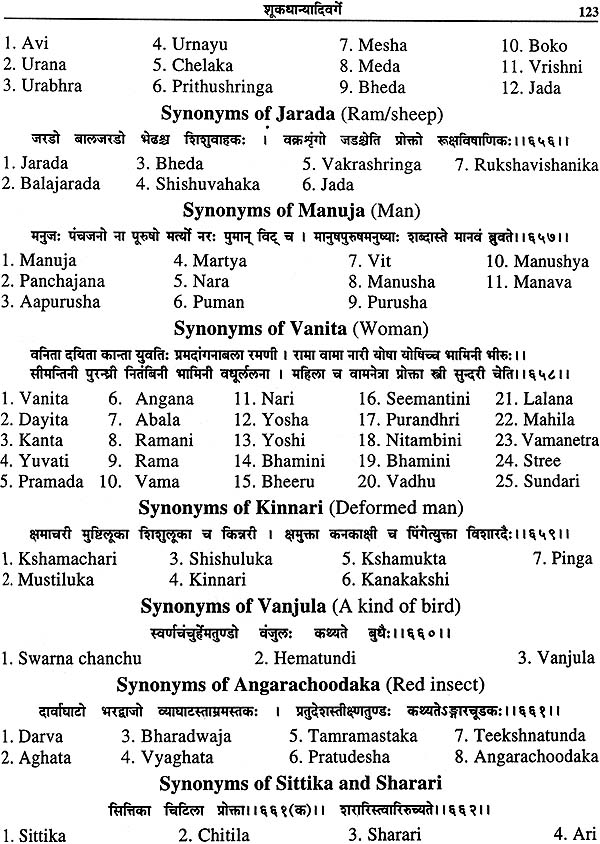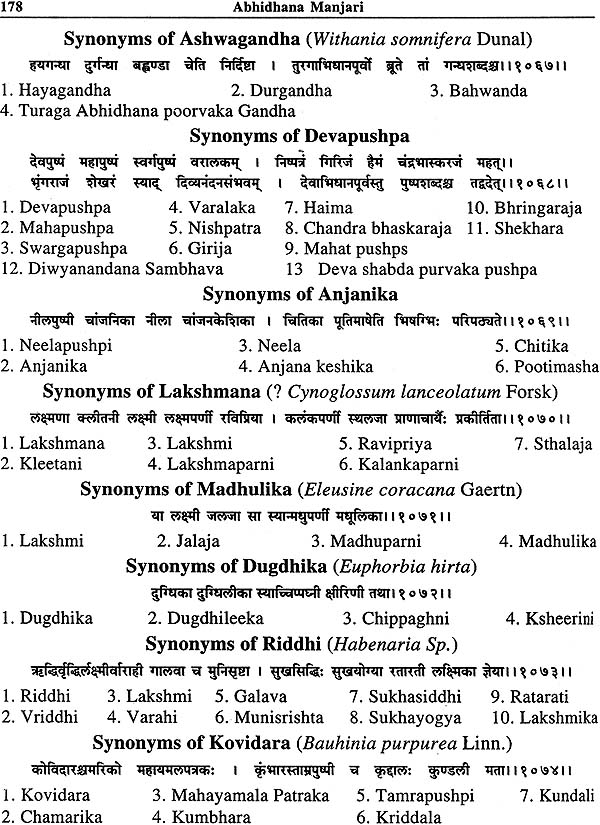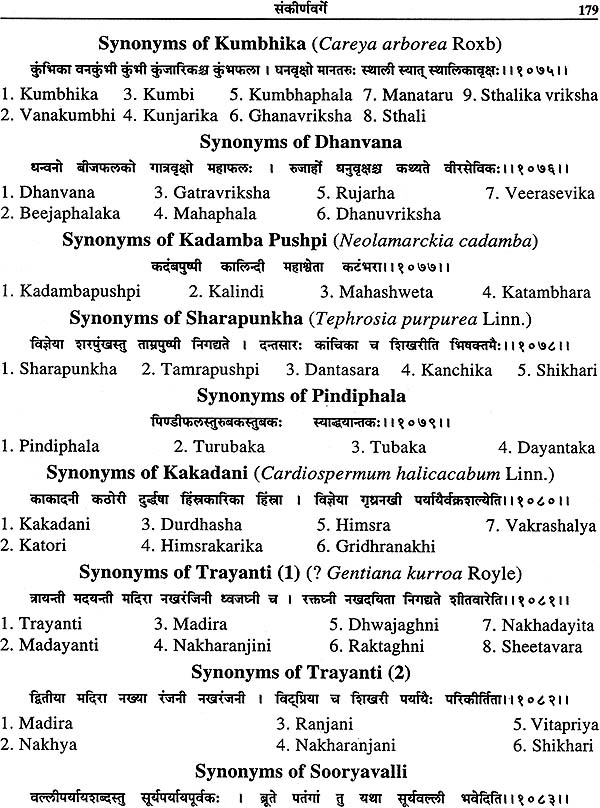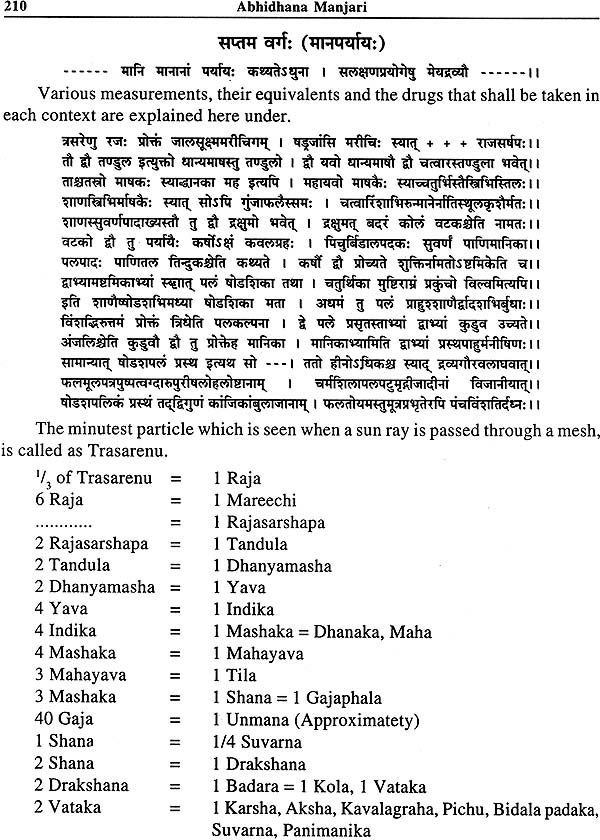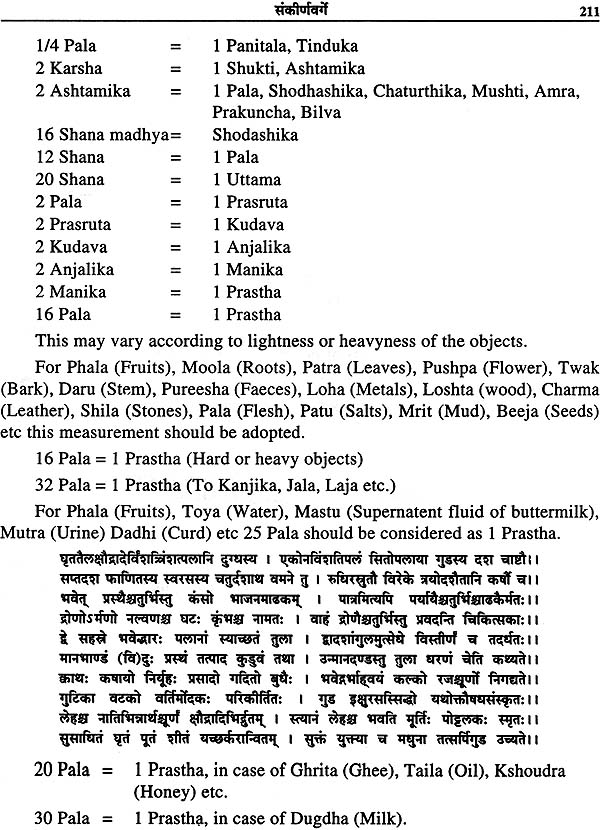
Abhidhana Manjari of Bhishagarya
Book Specification
| Item Code: | NAF973 |
| Author: | Dr. M. S. Krishnamurthy |
| Publisher: | Chaukhambha Orientalia |
| Language: | Sanskrit Text with English Translation |
| Edition: | 2012 |
| ISBN: | 9788176372558 |
| Pages: | 232 |
| Cover: | Hardcover |
| Other Details | 10.0 inch X 7.5 inch |
| Weight | 600 gm |
Book Description
The present book ‘Abhidhana Manjari’ is unique in its presentations, specially, with respect to the synonyms of various herbal drugs, mineral drugs, animal originated products, body parts etc. the author of the book Acharya Bhishagarya self declares that the text denotes the synonyms for the drugs and substances mentioned in Ashtanga Hridaya and such other texts of Ayurveda.
Other then multiple synonyms of a single drugs, the common synonymous words of several drugs are also codified here. Dwayarthaka, Trayarthaka, Chaturarthaka dravyas are the uniqueness of this text. Here and definitions are also given to clear the less explained subjects.
Manaparibhasha explained with much empha size on the nature of the drugs is the speciality of this text.
Botanical names and families quoted in the text by the author eases the reader to identify the drugs properly.
Dr. M.S. Krishnamurthy, born in Muliya-Alike, Bantwal Taluk, South Kanar District, Karnataka Completed his initial education from prestigious Institution of Karnataka-Sri Sathya Sai Loka Seva Education Trust (R) Alike. He completed his BAMS with IInd Rank and Gold Medal from ALN Rao memorial Ayurvedic medical college, Koppa and Post graduation MD (Ayu.) in Bhaishajya Kalpana in 2002, from IPGT and R, Jamnagar. His PG, Dissertation grabbed best thesis award (2002-Pune). He started his career as a lecturer in Alva’s Ayurved medical college, Moodbidri. During the period he got selected in UPSC (2000), CCRAS (2001) and Medical Officer (Direct recruitment-2005 Karnataka). But he continued as an Academician in the Ayurvedic College itself.
The author obtained his Ph D from NIA, Jaipur (2008) under the able guidance of Prof. L.K. Dwivedi for his work entitled “Pharmaco-chemical study of Takrarista and its SOP standardization.”
The author is also has the credit of young scientist Award (1999), National Congress on Traditional Medicine, Varanasi, and Bharateeya Vijnana Parishada Puraskar (2001-2005).
Presently, he is working as a Reader and HOD, PG Department of Bhashajya kalpana, Alva’s Ayurveda Medical College, Moodbidri, Karnataka. He is a reviewer for many of the indexed journals and has published more than 20 scientific papers in National and International Journals.
The experimentation, the observation and experience are the best ways for success. Ayurveda is the knowledge on Guna, Karma of Ayushyaani and Anaayushyaani Dravyaas. The knowledge of Dravyaas originally comes from Vedas which is scattered in many of the Indian literatures. It was the observational conclusions of our sages that there were no single drugs in the universe without medicinal values (Jagatyevamanoushadham).
The innumerable information and literatures of Ayurveda available in full or part to various extents had the state of depletion due o many unavoidable circumstances resulted irripairable, irrecoverable loss to immense treasures of Indian system of medicine on its concept and principles.
We observe a chronological developments and large series of contributions by commentators, Nighantukaaraas and Pandits on drugs identity and its applied aspects in Ayurveda.
The observations, information and the time tested experiences are hidden in the local languages, in the form of regional language books or in a system of mouth to mouth transformation. The Nighantus are the collections of these experiences, not only for the identification of the sources but also interpretation of terms of Samhitas and gradually adding their properties, therapeutic uses and gives great emphasis on the new drug discovery. The Paryaayas has been thoroughly coined and applied in general for describing the drugs in particular style and linguistic form.
Synonyms are not mere a set of terms but it gives complete profile of the drug sources , types, variants, properties, natural habitat, therapeutic applications etc.,
The total number of Sanskrit names of drugs mentioned in Caraka Samhita, Susruta Samhita and Ashtanga Hridaya are about 1100, 1270 and 1150, can these name of drugs include single source or many? Whether an Ayurvedic drug name can be attached to many biological source?
If we consider many sources, it may be a seasonally available one, suitable source, locally available, easily accessible variant o the source but almost equally effective. These sources either resemble with morphological features with properties and actions.
In Ayurveda a drug is claimed for many purpose, has wide therapeutic applications, sometimes we can predict, analyse the claims in a source; but, in many it is difficult in the selected source. If we look into the ‘Ahara’ of humanbeings, even though its purpose is same, we use different sources throughout the country.
The Brihateedvaya of Samhitas are explained as Ekaadasha brihatee in Kaiyyadeva nighantu, which refers addition of other sources to Brihatee with a bit different related names like Valli brihati, Sthoola brihati, Amla brihati, Vriksha rihati etc.,
The Simhi was considered as synonym of Brihati, Nidigdhika for Kantakari in Samhitas considered as four different types of Brihati in Nighantus, depicts synonyms or drug name refers to varieties and other sources. The same in the drug name of Bala, Parpata, Patala, Agnimantha, Saireyaka, Gokshura etc., where we consider more than one sources and claiming for the same property. Hence the Ayurvedic drug names cannot be attached to single biological source and it may be group of sources. One should clearly identify the source, understand the differences in the properties and develop the skill to observe the responses by applications. It minimizes the drug controversies.
Abhidhanamanjari, a text of synonyms of drugs of Shodhanaadi varga, Dhanyakaadi varga, Dravadravya and other related aspects along with the properties, varieties and applications of the drugs of Ashtanga Hridaya.
The synonyms given in this text are simple and the varieties mentioned are specific. The list of common drugs used in the practice for the synonyms explained in Sankeerna varga is helpful to the industry and practitioners for consideration of source.
The ethnomedicobotanical survey of every corner of India and neighbor countries, documentation of time tested experience of traditional informers, identification of the sources will be helpful to select the appropriate sources for the Sanskrit drug name of this text book and all other Ayurvedic treatises.
It is a great pleasure to write a few words on ‘Abhidhanamanjari’, hard work and vision of writer has given a nice frame to this book completely and inspired to work more on the book in future. I congratulate the translator Dr. M.S. Krishnamurthy and all other responsible authorities. Hope this work will preserve the wealth of plants and Ayurveda.
I am indeed very happy to go through this treatise ‘ Abhidhana Manjari’ written by Dr. M.S. Krishnamurthy, Associate Professor and HOD, PG Department of Bhaishajya Kalpana, Alva’s Ayurveda Medical College, Moodbidri. This is a most timely and useful publication of the scholar. His efforts in collecting and codification of the scattered literatures from various resources is highly appreciable.
Ayurveda is recognized for its doctrines. Proper presentation of scattered information is the need of the hour, which decreases the burden of the researchers. ‘Abhidhana Manjari’ is one such endeavour.
This book will never the less serve as a useful reference for the UG students, PG scholars, teachers, physicians and researchers. I hope the great deal of this work will fulfill he important need in the field of Dravyaguna Vijnana and Bhaishajya Kalpana.
I also congratulate the authorities of Chaukhambha Orientalia, Varanasi for taking up the responsibility of publication of this work for the cause of Ayurveda. I wish the author a bright future.
‘Abhidhana Manjari’ being one of the most valuable treasures of Dravyaguna Vijnana, has so far been confined to the people of one particular part (Kerla and Karnataka) only. Being without translation and lack of equivalent terms and botanical identities has restricted its exposure to the large mass. The grammatical errors existed upon the earlier treatises and unavailability of the original manuscripts too has caused inconvenience in that regard.
Here, I have tried hard to complete the words/lines of the verse by keeping the reference books got from the Oriental Research Institute, Mysore, Karnataka and a hand written manuscript obtained from the library of SAT High school, Manjeshwar, Kasargod, Kerala. Inspite of my keen observation and effort of correction, I could not find out the substitute words in some of the verses which were kept as it is and by the expert guidance that may be fulfilled in here after editions.
Being a book of Dravyaguna, Abhindhana Manjari discusses various matters related to Shareera Rachana, Shareera Kriya, Roga Nidana, Kayachikitsa, Shalyatantra, Shalakya Tantra, Prasootitantra, Manasaroga, Padarthavijnana, Swasthavritta, Bhaishajya Kalpana and Rasasashtra. Even though the intention of the author Bhishagarya is to narrate the synonyms in a systematic order, one can find the sequential errors and grammatical mistakes here and there. Probably the unavailable original documents of the true author would have caused such a lecuna in this text. Secondly, the author referes the definition for many of the words used in the treatises, especially in the contexts of Shareeea Rachana, Shareera Kriya and Roga vijnana.
The book is complete in 4 Vargas namely-
1. Madanadi Gana Varga
2. Shooka dhanyadi Varga
3. Drava Dravyadi Vijnaneeya Varga (Toyadi Varga) and
4. Sankeerna Varga
Madanadi Ganavarga comprises of 32 chapters and in each chapter various groups of the drugs are explained with their synonyms. Shookadhanya varga is completed in 7 chapter, where much emphasis is given towards the food and beverages as well as fruits and vegetable.
Third, Dravadravyadi Vijnaneeya Varga is completed in 5 chapters and Toyavarga, Ksheeravarga, Ikshuvarga, Tailavarga and Madyavarga were dealt here. Most of the liquids were explained here with their synonyms.
Sankeerna Varga, in 1st chapter, namely Prathama Varga, 32 different herbo-mineral preparations were taken into consideration, which include, some rare and less explained substances like Gangeya, Shatakumbha, Kartaswara, Karbura, Bhoori, Bharma, Ashtapada, Maharsha, Kaladhouta, Bhooshanarha, Shreeniketana, Vahnireta, Vasu etc. Hence, it makes one clear regarding the drugs to be taken, in routine practice. Still, some of the drugs remain unidentified now-a-days.
In 2nd chapter of Sankeerna Varga, Lokaprasiddha bhavas were explained. In a brief way, on codification, the synonyms of 30 substances were explained with their common synonymous words. Surely this helps one to identify the drugs explained in various contexts of Ayurvedic texts.
3rd chapter of Sankeerna Varga deals with Ekartha Varga, where specific drugs to be taken by a single word is highlighted. 98 such substances are enumerated by the author under this heading.
Likewise, in 4th chapter, 149 drugs with two of the synonymous words are codified. In 5th and 6th chapter, the drugs of 3 and 4 synonyms were explained and such enumerations were carried for 100 and 37 drugs respectively.
Lastly, means of measurements are also mentioned; which stand unique as much specification is made based on the volume and liquidity of the substances.
I have tried hard to give botanical names as well as chemical names for the drugs referred here. In spite of that, it will be very difficult to find out an exact variety/sub variety in many of the contexts. The opinions and suggestions which may be received in due course of time will be surely incorporated in further editions. I seek the earnest help and support of the people of great intellect to find out the most nearer/useful botanical species which may be considered for the present day practice.
I am sure that this endeavor will be useful at the large to the Ayurvedic scholars and researchers of the field. Meanwhile, I am open for the suggestions and critics regarding the contexts of this translation work.
I convey my deep sense of gratitude to all my teaches, colleagues and friends.
My sincere thanks are due to Dr. M. Mohan Alva, Chairman of Alva’s Education Foundation (R) Moodbidri, for his constant encouragement. Here, he has bestowed me with his foreword also. I offer mute reverence for his gratitude.
I am highly thankful to Dr. Shreedhara Bairy, Professor and Physician, SDMCA, Udupi, a right person who has reviewed this write up, suggested the needs and enlightened with prologue.
I am very much Thankful to Dr. Mahabalesh, Lecturer, Alva’s Ayurveda Medical College for his beautiful front page design.
I submit my heartfelt thanks to my father, Mr. Muliya Shankara Bhat and mother Mrs. Gowri. S. Bhat, whose constant blessings gives me energy to carry out the higher endeavors. The support and encouragement of my wife Mrs. Padmashree and daughter Kum. Maithree keeps me cheerful and enthusiastic. My special thanks are due to them.
I am highly obliged to Mr. Atul Gupta and team members of Chaukhambha Orientalia, Varanasi for undertaking the publication of this work.
Lastly, I pay my obeisance to all the sages and Acharyas of Ayurveda, who have enriched the science and blessed the sufferers with their magic healing power.
